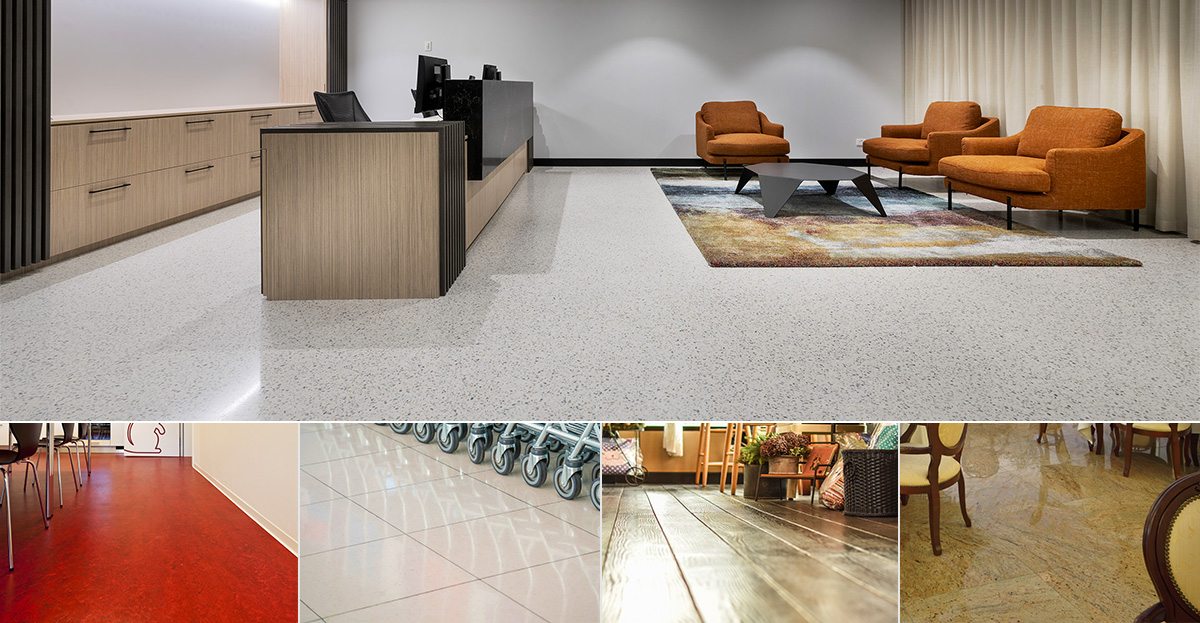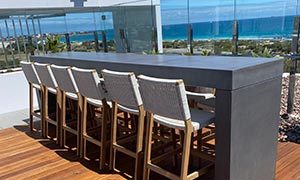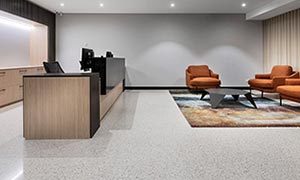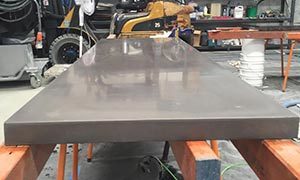Polished concrete offers builders multiple benefits not found in most other flooring materials. It’s as sleek and stylish as any natural stone available. However, it’s not as difficult to source or expensive to install as marble or granite. It also beats vinyl, wood or ceramic tiles in terms of overall cost-effectiveness.
In this article, we’ll compare polished concrete to other flooring materials in the market. Let’s find out just how much it stacks against the competition.
What is polished concrete?
Polished concrete is the process of mechanically grounding, honing and polishing concrete floors. It also involves the use of chemical sealers to help dust-proof the concrete. The result is a glossy and reflective surface similar to those natural stone floors like slate, marble and granite.
How does polished concrete perform compared to other flooring materials?
We compared polished concrete with some of the most popular flooring options available. We wanted to know how well it fares in terms of durability, maintenance, sustainability and other factors.
Durability
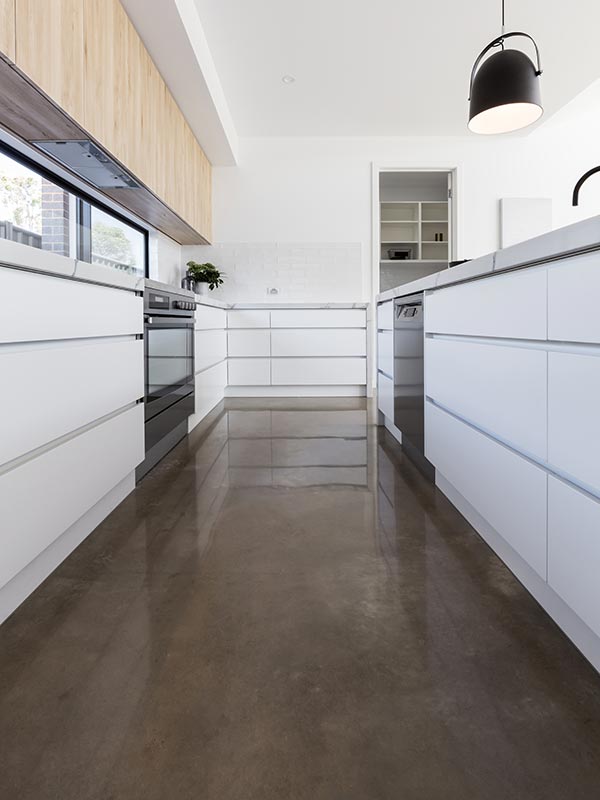
When choosing a flooring option, durability should always come first. Depending on what room your floor is going to be located, it could get a lot of foot traffic on a given day. It should be strong and tough enough to handle that much of a load.
Many people choose natural stones because of how strong they are. Granite, marble and limestone can last for years. However, they’re not as readily available as other flooring materials. This makes them much more expensive to use. Natural stone slabs are also heavier and much more difficult to handle on-site.
You can choose other options such as vinyl, linoleum and ceramic tiles. They offer some level of durability but as much as natural stone. Most products also can’t handle high volumes of foot traffic. They’re much more susceptible to wear and tear, especially when used for longer periods.
Meanwhile, wood and wood laminate can take on heavy loads better than vinyl, linoleum and ceramic tiles. However, they don’t do well when exposed to moisture and stains. Seepage can also severely damage wood floors.
Of all flooring options available, polished concrete offers nearly the same level of durability as natural stone. Once the poured concrete sets and dries, it’s almost as strong and durable as granite or marble. It doesn’t scratch, crack or chip easily even when used a lot. Polished concrete is also much more workable and affordable than natural stone. This means you won’t have to worry about breaking your back or the bank when using it as flooring.
Winners: Natural stone and polished concrete
Maintenance
Another important factor you need to consider is maintenance. How much work does it take to keep the structural integrity of your floor? How often do you need to clean it?
For most flooring options, regular cleaning involves sweeping and vacuuming dust and other particles from surfaces. It also includes mopping any spills and moisture. This is true for vinyl, linoleum and ceramic tiles. Most products feature protective layers that keep them from getting damaged. However, some materials may need machines and chemical agents to properly clean and maintain.
Wood floors typically come with layers of lacquer or oil to prevent their surfaces from getting moisture damage. But this protection can easily wear off because of frequent use. You’ll need to have your floor recoated to restore the lacquer or oil layers.
Natural stone floors may need some machine-assisted cleaning to get rid of efflorescence. This is the white powdery residue that often appears on stone surfaces, especially after water exposure. The water carries the salt deposits from within the stone to the surface. The minerals then recrystallizes after the water evaporates. You may have to use a cleaning machine along with mild cleaning agents to effectively remove the residue.
Polished concrete floors don’t suffer from these problems. When installing the concrete, manufacturers make sure that the surface is tightly compacted. This is to prevent it from developing any stains. Makers also apply sealers that help protect the floor from scratches and denting.
With polished concrete, you won’t have to worry about efflorescence either. The polishing process helps reduce any residue build up on the concrete’s surface,
Winner: Polished concrete
Resistance to humidity, moisture damage and allergen buildup

Humidity and moisture can really do a number on your floor. Some flooring materials tend to be more susceptible to damaging from the environment than others.
Most ceramic tiles come with protective layers. These help keep them from getting damaged from humidity and moisture. This makes them a popular choice for kitchens, where the floor regulars gets exposed to spills and stains. However, they can accumulate molds particularly in the spaces between each tile.
As mentioned above, wood floors are particularly weak against moisture. They often absorb whatever liquid that gets poured onto their surface. This leaves them distorted, warped or discoloured. Unfortunately, moisture damage on wood floors are often permanent. It can also cause molds to build up on affected areas.
Natural stone provides better resistance to moisture than wood. However, too much exposure to water can still create problems for stone floors. Efflorescence occurs when the stone is exposed to water. Low temperatures and condensation increases the likelihood of the white residue to appear. Efflorescence particles can cause mild irritation, especially to the eyes.
Polished concrete has excellent scores when it comes to humidity and moisture damage resistance. Manufacturers tightly compact the concrete during installation to keep water from seeping. The resulting non-porous surface also prevents the material from absorbing spills.
While unpolished concrete does allow for efflorescence to build up, the polished version doesn’t. It also doesn’t support the growth of molds.
Many laboratories and medical facilities prefer to use polished concrete floors. It doesn’t suffer from moisture build up as much as other flooring materials. This slip resistance property reduces the risk of accidents in workplaces significantly.
Winners: Polished concrete
Sustainability
Polished concrete excels as a sustainable and environment-friendly flooring option. Most concrete mixes are made using limestone, one of the most abundant minerals on the planet. Some mixes even use recycled waste byproducts such as fly ash and slag cement as their raw material.
Natural stone suppliers claim that the material is also a green option. Quarrying for granite, marble or slate doesn’t require the use of any harmful chemicals or toxins after all. To produce slabs of the material, manufacturers extract large quantities of rock and stone from the earth.
The same is also true for wood floors. To produce enough wood planks for construction, manufacturers would have to harvest a lot of hardwood or softwood trees. You can settle for wood laminate, but you won’t have the same look and durability as solid hardwood.
Meanwhile, vinyl (linoleum) sheets and tiles are made from synthetic materials. Most of the ones available in the market are manufactured from polyvinyl chloride, also known as PVC.
Winners: Natural stone and polished concrete
Lifetime maintenance cost
Vinyl and ceramic tiles provide the most affordable solution out of the five selections we’ve discussed. A budget vinyl flooring can cost you around $30 per square metre. Meanwhile, a vinyl plank flooring can cost you around $55 to $90 per square metre. That’s not a bad deal, especially if you’re looking to save money. But since vinyl isn’t as durable as other materials, it will cost you more to replace damaged tiles. The same goes for ceramic tiles.
Wood and natural stone flooring are both highly durable. However, their buying and installation prices can burn a whole right through your pocket. They’re also much more expensive to maintain compared to vinyl and ceramic tiles.
Polished concrete provides nearly the same benefits as natural stone without the high price tag. Since it’s highly durable, you won’t have to worry about paying extra for costly maintenance work. It also doesn’t cost a fortune to repair damaged concrete floors.
Winner: Polished concrete
Availability in various design options
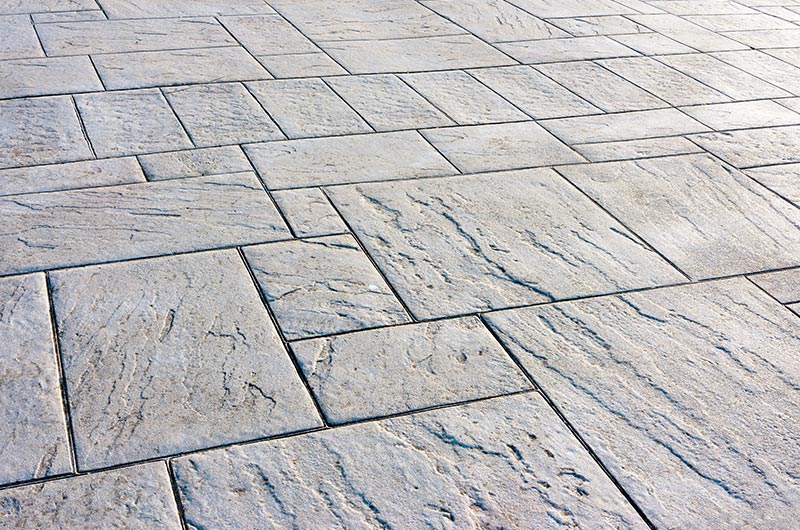
Last but certainly not the least is design versatility. Is your flooring option available in various shapes and colours? Can you use it in different construction designs?
Polished concrete is easily the most versatile of the group. Since it comes in a fluid mixture, concrete can take on any shape that you need. You can also use it to make more intricate designs for your floor. Some manufacturers even add recycled products such as crushed glass to create a distinct look for their polished concrete floors.
Wood and natural stone both make gorgeous flooring. You can buy wood floors in dark and light colours to complement both classical and modern spaces. You can also choose wooden planks in different sizes, accents, grains and finishes.
On the other hand, natural stones such as granite, marble, travertine and limestone are all beautiful to look at. They are available in a wide array of colours, tones, textures and patterns. A natural stone floor can easily add an air of timelessness and sophistication to any space.
Vinyl and ceramic tiles are often available in different colours and designs. However, they typically follow a specific look. You can try to mix and match different tiles and sheets together, but it’s hard to achieve a cohesive design.
Winners: Wood, natural stone and polished concrete
Polished concrete vs other flooring materials
The table below shows how polished concrete stacks up against other flooring options. As you can see, the material does pretty well for itself in terms of dependability and overall value for money.
| Vinyl / Linoleum | Ceramic tiles | Wood / Wood laminate | Natural stone | Polished concrete | |
| Durability | Good | Good | Good | Excellent | Excellent |
| Maintenance | Good | Good | Good | Good | Excellent |
| Vulnerability to humidity and moisture damage | Yes | No | Yes | No | No |
| Susceptibility to allergen build up (molds, mildews & dust mites) | No | No | Yes | No | No |
| Sustainability as flooring alternative | Depends (if natural materials were used) | Yes | Depends (if natural materials were used) | Yes | Yes |
| Lifetime maintenance cost | Moderate | Low | Moderate | Low | Very low |
| Availability in various design options | Yes | Yes | Yes | No | Limitless |

The verdict
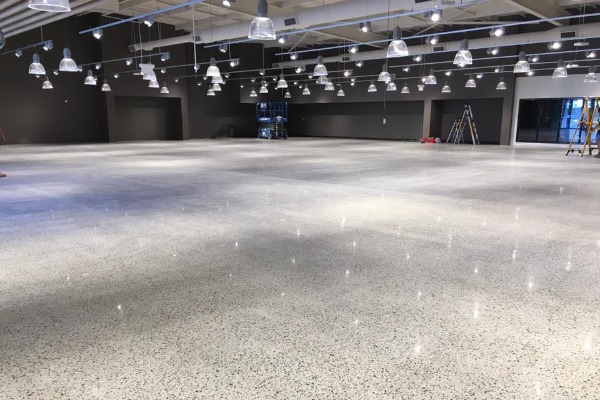
If you’re looking for a solid flooring option, polished concrete is as good as any. Its strength and durability are already on par with other popular materials.
But its versatility and sustainability help make it the best choice available.
Give polished concrete floors a try so you can experience their many benefits for yourself. At Art of Concrete, we’re always happy to help you find the best concrete solutions for your building needs.

